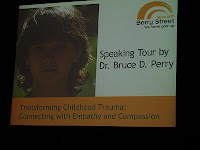 A friend and I shared a very wonderful day at the Brisbane Convention Centre listening to Dr Bruce D. Perry’s insights on childhood trauma and recovery models. The auditorium was full of his fans from far and wide. Dr Perry certainly can take his audience to an exciting trip though the human brain development. The research and the case stories he shared with the spectators were extremely well streamlined within his presentation.
A friend and I shared a very wonderful day at the Brisbane Convention Centre listening to Dr Bruce D. Perry’s insights on childhood trauma and recovery models. The auditorium was full of his fans from far and wide. Dr Perry certainly can take his audience to an exciting trip though the human brain development. The research and the case stories he shared with the spectators were extremely well streamlined within his presentation. I was immediately captured by his comments on the age old practice of having your child sleeping next to you and his declaration that the modern preference to separate the children from their parents is not respecting the natural children’s brain development which is dependent on the building of a close nurturing relationship between the primary carer and the child. The closer and the more fostering this relationship is the better for the future of the child’s ability to feel empathy and be compassionate towards other human beings. Coming from a culture where this is a widely accepted practice, his declaration felt good to hear.
I was immediately captured by his comments on the age old practice of having your child sleeping next to you and his declaration that the modern preference to separate the children from their parents is not respecting the natural children’s brain development which is dependent on the building of a close nurturing relationship between the primary carer and the child. The closer and the more fostering this relationship is the better for the future of the child’s ability to feel empathy and be compassionate towards other human beings. Coming from a culture where this is a widely accepted practice, his declaration felt good to hear. The other most remarkable comments by Dr Perry were that 65% of all the calories a newborn takes with food are consumed by the brain and a four-year old brain has already created 90% of all its functions, including the primary sense of being.
For me it is interesting to note how the brain works in practice by following my own memories that relate to philanthropic, charitable and humane thinking processes in my own life. It is also fascinating to analyse my own attitudes and through self analysis get to know what determined my world today. I have heard this saying so many times in the context of consideration about the rising consciousness: “if you look at yourself now, you know what you were in the past and if you look at your thoughts today, you know what you’ll be in the future.” These types of comments are often articulated in such discussions that conclude to consider words things. This process is concerned of realising an idea in the material world. The thoughts solidify into words and these words solidify into actions and ultimately may materialise as things.
I have two vivid memories that relate to developing as a humane human being, the other voiced by my own mother, with a long career as a teacher in Lapland, Finland and the other a friend in India, with a long career as a doctor and lately a director of Kristnamurti Educational Centre in Bangalore. Both are concerned in educating children to become compassionate human beings. My mother says that we should be learning to eat with a spoon from an early age and sit up properly on our chair as it is part of our culture. My Indian friend says that the two most useless inventions by humans are the spoon and the chair as when we eat with our fingers, our touch is also stimulated and when we crouch, our posture is kept firm and we keep healthy. Both are occupied and agree in bringing up healthy and able human beings. It is remarkable how human beings can start from two totally opposite directions and be of the same mind on the whole. To me this is a demonstration of how unity can be created from diversity. There is not only one way to do things, but many as long as the goal is agreed upon.
 Listening to Dr Bruce Perry, who is an expert in brain plasticity, for a day on childhood trauma and recovery models, helped me to realise that we can also take a scientific approach and use our current knowledge of how the brain develops and functions as a tool to enhance and aid the transformation of the human consciousness.
Listening to Dr Bruce Perry, who is an expert in brain plasticity, for a day on childhood trauma and recovery models, helped me to realise that we can also take a scientific approach and use our current knowledge of how the brain develops and functions as a tool to enhance and aid the transformation of the human consciousness. A few thoughts clearly stood out for me on the day in relation to my search for the philanthropic thinking models:
1. The initial quotation Dr Perry used, from W.R. Inge, namely: “The best time to influence the character of a child is 100 years before they are born.” – This relates to longtime hereditary approach.
2. “Our brain allows us to absorb the accumulated and distilled experience of thousands of previous generations in a single lifetime.”
3. The utmost plasticity of the brain, which allows us to rebuild and re-organise the brainstems, diencephalon, the limbic system and the neocortex of the brain from the basic stems to the more complex systems and the other way around from the cortex to the basics. – This leads to that we can influence the brain in positive ways by providing ‘pattern repetitive inputs’.
4. The utmost co-dependence of the organisation of our brain to the close human relationships we have initially formed or the lack of them – The power of human relationships.
5. “From the neural developmental perspective, we need to be respectful of our biology in the process of inventing our reality.”
6. Being born a human does not ensure that a child has the capacity to care, to share, to listen, to be empathetic and have values or to be compassionate. This develops from being cared for. - “Humans become humane.”
7. Human mind pays more attention to the negative comments than to positive. The negative responses we get from our relationships outnumber the positive by 3:5 – “Everybody needs their rewards bucket filled every day.”
It is very comforting and positive to know that Dr Perry’s ‘Neurosequential Model of Therapeutics’ is producing results in the ‘treatment’ of trauma in children. The knowledge that it is possible to work closely together with the traumatised children and their families by using this model by first mapping and then re-organising the brain that has been maltreated in the past, brings with it new realisations of the possibilities imbedded in the utmost plasticity of the brain. What is incredible is that even though the human beings when creating our world seem to have little respect of our neurobiology and instead mostly work against it, it is never too late to re-organise and re-create our reality to better suit the natural environment.
Thinking of the model and the information I got from the seminar, through the handout reading materials and some additional research I could easily draw a direct line to philanthropic thinking models. The same realisations could be used in determining that people with little empathy or inclination to charitable or philanthropic thinking or action have some trauma to recover from. If we would think that a fully mature humane human being does possess the capacity to be compassionate and empathetic, then there must be a way to re-organise the brain to realise this aim.
Many practices aiming at raising human consciousness that we are accustomed to are based on repetitive impulses, yoga-practice for example and mediation, music and movement, prayer and much of singing, particularly traditional folk singing and dancing, even some traditional ways to create art. These practices have been developed during many centuries. We find them comforting and often revert to them when in need to ‘fill our rewards bucket’. All this practice requires close human interaction and relationships in the community to learn.
 Lot of what Dr Perry said during the day is something that I knew before, scattered in little bits of information here and there. There has been much scientific research done on following young children to adulthood and through this it is evident that the brain takes longer to develop to its full mature capacity than thought before. The latest research says that we can only expect a 27-year old brain to be fully mature. Other topical interesting research concerns hypothalamus and its functions in sorting out human emotions and the blends of emotions. Our day with Dr Perry brought this research in sharper focus for me. I am really looking forward to reading his book Born for Love; Why Empathy is Essential and Endangered, written with Maia Szalavitz. The reading material that was handed out has been a great source of information. Lots of it can be found in the Child Trauma Academy Website as well. http://www.childtrauma.org/ It is well recommended.
Lot of what Dr Perry said during the day is something that I knew before, scattered in little bits of information here and there. There has been much scientific research done on following young children to adulthood and through this it is evident that the brain takes longer to develop to its full mature capacity than thought before. The latest research says that we can only expect a 27-year old brain to be fully mature. Other topical interesting research concerns hypothalamus and its functions in sorting out human emotions and the blends of emotions. Our day with Dr Perry brought this research in sharper focus for me. I am really looking forward to reading his book Born for Love; Why Empathy is Essential and Endangered, written with Maia Szalavitz. The reading material that was handed out has been a great source of information. Lots of it can be found in the Child Trauma Academy Website as well. http://www.childtrauma.org/ It is well recommended. I greatly appreciate all comments for future development.















